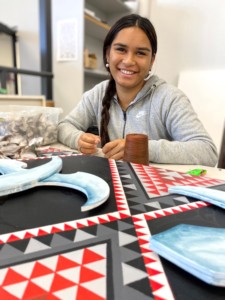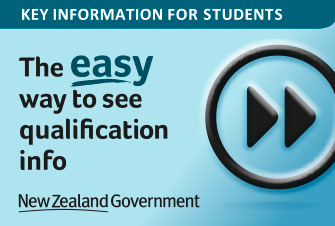- Home
- Toihoukura / Māori Art and Design
- Te Pitau a Manaia (Kaupae 5) | NZ Diploma in Ngā Toi (Level 5)
Te Pitau a Manaia (Kaupae 5) | NZ Diploma in Ngā Toi (Level 5)
Toihoukura! Toihoutangata! Toihoukura!
Māori art is a specialist field that is highly sought after nationally and internationally.
Te Pitau a Manaia is a unique diploma which is kaupapa and wānanga based. You will have access to recognised tohunga and leading Māori art specialists across a range of artforms.
Te Ao Māori is interwoven throughout the program and provides a basis for self-expression in the creation of artworks using a variety of mediums.
You will be introduced to a wide range of art disciplines, with a view to specialisation if you opt to continue your Toihoukura journey. Toihoukura wānanga based delivery provides the opportunity to link past traditional practices whilst allowing scope for expression in a modern context. Successful completion of Te Pitau a Manaia | NZ Diploma in Nga Toi enables you to apply directly for Year Two of Te Toi o Nga Rāngi | Bachelor of Māori Visual Arts at Toihoukura.
Your future career and study opportunities
Career opportunities can include:
- Practicing artist
- Teacher
- Gallery and exhibition curator
- Hapu and Iwi, Rūnanga and community group positions
- A wide range of creative industry vocations
Pathway to postgraduate studies:
- Te Toi o Nga Rangi | Bachelor of Māori Visual Arts
- Te Hono ki Toi (Poutiri-a-Rangi) | Bachelor of Creative Practice (Honours) (Level 8)
- Te Ara Pourewa | Graduate Diploma in Heritage and Museum Studies
- Te Hono ki Toi (Poutiriao) | Master of Professional Creative Practice

Outline
Te Pitau a Manaia | NZ Diploma in Ngā Toi (Level 5) is a one year, 120 credit course. It is taught by some if Aotearoa New Zealand’s premier Māori artists and is well supported by Aotearoa New Zealand’s Māori art sector, communities and a range of leading Māori art specialist across the nation.
You will develop your creativity through focusing on art practice enforced by traditional research methods. Learners at Toihoukura come from all corners of the world, however studies are primarily informed by te reo Maori me ngā tikanga o Te Tairāwhiti.
Toihoukura has a busy exhibition schedule for all year levels with shows not only in our own gallery Maia but nationally and internationally. Marae and wānanga based learning continues to be a main focus ensuring our art remains culturally authentic and connected.
Tauira
- Realise their full potential intellectually and creatively.
- Understand the importance of te reo Māori.
- Affirm the importance of te reo, tikanga, kawa and mōteatea as the basis of Māori artistic expression.
- Are effective and confident art professionals.
- Can contribute to the restoration, conservation and development of art and design skills and practices unique to hapū, iwi and waka.
- Are confident and competent in all aspects of Māori culture relevant to Māori art and design.
- Are confident to contribute to projects locally, nationally and internationally.
Nau Mai e Hika ma…
Dates
There is one entry date per year:
- February
Entry
Entry requirements
Entry Criteria
A person is eligible to apply for entry who:
- Has attained University Entrance (UE)
- Can satisfactorily prove that they have the potential to succeed on the programme and is over the age of 20 years by the official start date of the programme
- Level placement, cross credit and/or recognition of prior learning as approved by the Academic Committee
Standard discretionary entrance guidelines will apply. Please contact us to discuss.
Selection criteria and process
An offer of a place on the programme will be extended to applicants who meet the entry criteria and demonstrate the potential to successfully complete the programme on the basis of:
- A portfolio of work that represents the applicant’s level of achievement
- An interview
- Evidence of ability to cope with the academic demands of the programme (for those without a University Entrance qualification)
- Curriculum vitae (optional)
Applicants who submit a formal application to enrol on the programme and who meet the entry criteria will be required to submit a portfolio of work and attend an interview.
The interview provides an opportunity for academic staff to confirm the authenticity of the applicant’s portfolio, appraise and discuss work in considering the applicant’s suitability for admission. It will determine whether an applicant is offered a place on the programme and if so at what level of the programme the applicant will be offered a place. The interviews will include two or more academic staff.
Māori/English language entry requirements
Applicants will need to demonstrate fluency, at a level sufficient to academically succeed in the course, in either Te Reo Māori or English.
Applicants who have the language fluency to support it may complete their assessments in Te Reo Māori.
Applicants from countries in which English is not a primary spoken language, who propose to complete their assessments in English, must have an acceptable level of English language fluency prior to enrolment in the programme. This may be demonstrated in a variety of ways, including successful study of a programme in which English was the language of instruction, completion of a New Zealand Certificate in English language (Level 4 Academic), approved scores on IELTS tests (6.0 Academic with no band score lower than 5.5), or completion of either an EIT | Te Pūkenga assessment or accepted international equivalents.
Standard discretionary entrance guidelines will apply.
Entry with credit
Recognition of prior learning
Cross Credit (CC) and Recognition of Prior Learning (RPL) will be in accordance with EIT | Te Pūkenga regulations and institutional guidelines. Level Placement (LP) is a type of recognition of prior learning that has special relevance to this diploma and regulations that are particular to this diploma are dealt with below.
The maximum amount of credit achievable by CC or RPL is 90 credits.
Acceptance of RPL and LP will be at the discretion of EIT | Te Pūkenga. You will still need to be interviewed with a submission of portfolio.
Level placement
Applicants to the programme may apply for level placement or it may be recommended by academic staff during the application interview.
Applicants for level placement will provide evidence of relevant experience and achievement through the selection process.
Applicants must also demonstrate the ability to cope with the academic demands of the level at which they are being placed. If an applicant is applying for level placement, it is recommended that they submit a curriculum vitae as part of their application for admission to the programme.
Once an applicant’s level placement has been formally approved, they will be granted academic credit for those courses between the entry level and the level at which they have been placed, that is, those courses at level 5 and above from which they have been exempted.
For information and enquiries about CC and RPL please contact Emma Marino, the Programme Administrator, on 06 869 0847.
Academic learning services
Academic Learning Services is here to assist you on your journey towards the successful completion of your studies at EIT | Te Pūkenga. Our aim is for you to become confident, competent and independent learners.
We have dedicated advisors who can assist with your learning.
Find out more:
Scholarships
 EIT | Te Pūkenga offers a variety of scholarships across various subjects and programme levels. Some scholarships are based on your age, some are specific to the subject you want to study. Not all scholarships are based on your academic ability and anyone wanting to study should investigate what scholarships are available to them.
EIT | Te Pūkenga offers a variety of scholarships across various subjects and programme levels. Some scholarships are based on your age, some are specific to the subject you want to study. Not all scholarships are based on your academic ability and anyone wanting to study should investigate what scholarships are available to them.
You can find a list of EIT | Te Pūkenga scholarships here however there are many more scholarships offered nationally. Information about these is on an database called “givME”. givME is accessible at EIT | Te Pūkenga or at some public libraries. If you would like to come to EIT | Te Pūkenga to look through the giveME database don’t hesitate to contact scholarships@eit.ac.nz or call in for a chat.

